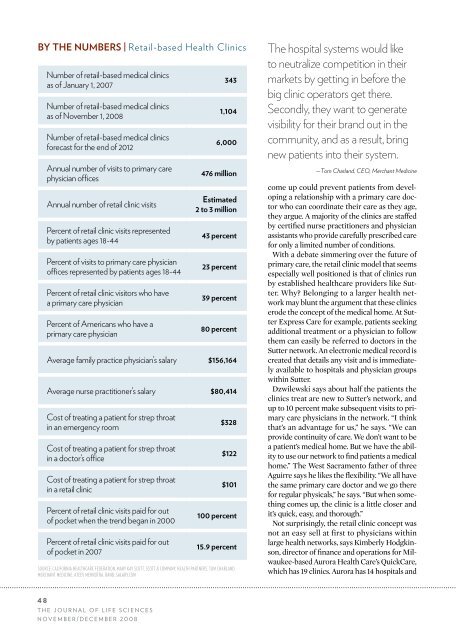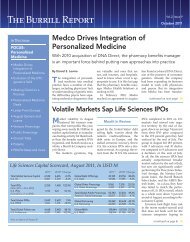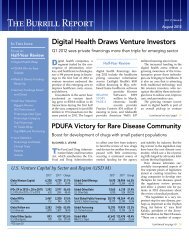The Sex Issue - The Burrill Report
The Sex Issue - The Burrill Report
The Sex Issue - The Burrill Report
You also want an ePaper? Increase the reach of your titles
YUMPU automatically turns print PDFs into web optimized ePapers that Google loves.
By the Numbers | Retail-based Health Clinics<br />
Number of retail-based medical clinics<br />
as of January 1, 2007<br />
Number of retail-based medical clinics<br />
as of November 1, 2008<br />
Number of retail-based medical clinics<br />
forecast for the end of 2012<br />
Annual number of visits to primary care<br />
physician offices<br />
Annual number of retail clinic visits<br />
Percent of retail clinic visits represented<br />
by patients ages 18-44<br />
Percent of visits to primary care physician<br />
offices represented by patients ages 18-44<br />
Percent of retail clinic visitors who have<br />
a primary care physician<br />
Percent of Americans who have a<br />
primary care physician<br />
343<br />
1,104<br />
6,000<br />
476 million<br />
Estimated<br />
2 to 3 million<br />
43 percent<br />
23 percent<br />
39 percent<br />
80 percent<br />
Average family practice physician’s salary $156,164<br />
Average nurse practitioner’s salary $80,414<br />
Cost of treating a patient for strep throat<br />
in an emergency room<br />
Cost of treating a patient for strep throat<br />
in a doctor’s office<br />
Cost of treating a patient for strep throat<br />
in a retail clinic<br />
Percent of retail clinic visits paid for out<br />
of pocket when the trend began in 2000<br />
Percent of retail clinic visits paid for out<br />
of pocket in 2007<br />
$328<br />
$122<br />
$101<br />
100 percent<br />
15.9 percent<br />
Source: California Healthcare Federation, Mary Kay Scott, Scott & Company, Health Partners, Tom Charland,<br />
Merchant Medicine, Ateev Mehrotra, RAND, salary.com<br />
<strong>The</strong> hospital systems would like<br />
to neutralize competition in their<br />
markets by getting in before the<br />
big clinic operators get there.<br />
Secondly, they want to generate<br />
visibility for their brand out in the<br />
community, and as a result, bring<br />
new patients into their system.<br />
—Tom Charland, CEO, Merchant Medicine<br />
come up could prevent patients from developing<br />
a relationship with a primary care doctor<br />
who can coordinate their care as they age,<br />
they argue. A majority of the clinics are staffed<br />
by certified nurse practitioners and physician<br />
assistants who provide carefully prescribed care<br />
for only a limited number of conditions.<br />
With a debate simmering over the future of<br />
primary care, the retail clinic model that seems<br />
especially well positioned is that of clinics run<br />
by established healthcare providers like Sutter.<br />
Why? Belonging to a larger health network<br />
may blunt the argument that these clinics<br />
erode the concept of the medical home. At Sutter<br />
Express Care for example, patients seeking<br />
additional treatment or a physician to follow<br />
them can easily be referred to doctors in the<br />
Sutter network. An electronic medical record is<br />
created that details any visit and is immediately<br />
available to hospitals and physician groups<br />
within Sutter.<br />
Dzwilewski says about half the patients the<br />
clinics treat are new to Sutter’s network, and<br />
up to 10 percent make subsequent visits to primary<br />
care physicians in the network. “I think<br />
that’s an advantage for us,” he says. “We can<br />
provide continuity of care. We don’t want to be<br />
a patient’s medical home. But we have the ability<br />
to use our network to find patients a medical<br />
home.” <strong>The</strong> West Sacramento father of three<br />
Aguirre says he likes the flexibility. “We all have<br />
the same primary care doctor and we go there<br />
for regular physicals,” he says. “But when something<br />
comes up, the clinic is a little closer and<br />
it’s quick, easy, and thorough.”<br />
Not surprisingly, the retail clinic concept was<br />
not an easy sell at first to physicians within<br />
large health networks, says Kimberly Hodgkinson,<br />
director of finance and operations for Milwaukee-based<br />
Aurora Health Care’s QuickCare,<br />
which has 19 clinics. Aurora has 14 hospitals and<br />
48<br />
<strong>The</strong> Journal of Life Sciences<br />
november/december 2008












